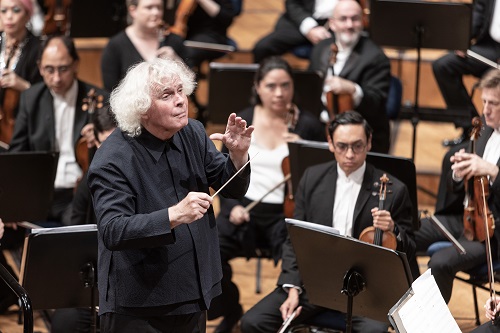
 Switzerland Lucerne Festival [4] – Sibelius, Bruckner: London Symphony Orchestra / Sir Simon Rattle (conductor). Kultur- und Kongresszentrum Luzern (KKL), Lucerne, 3.9.2022. (JR)
Switzerland Lucerne Festival [4] – Sibelius, Bruckner: London Symphony Orchestra / Sir Simon Rattle (conductor). Kultur- und Kongresszentrum Luzern (KKL), Lucerne, 3.9.2022. (JR)

Sibelius – The Oceanides , Op.73; Tapiola, Op.112
Bruckner – Symphony No.7, WAB 107 (Benjamin-Gunnar Cohrs Edition)
Sir Simon Rattle began conducting Sibelius in his teenage years and his affection and affinity for this composer’s works has never waned. For some reason, Sibelius is performed much more in the UK than on the continent; certainly, we hear few of his works in Switzerland, other than his Violin Concerto. We hope that Paavo Järvi and the Tonhalle Orchestra Zurich will soon make amends.
This concert opened with the Oceanides. This is pure impressionism. Sibelius veered from his usual Kalevala (Nordic legends) source of inspiration, instead finding stimulation from Greek mythology. The ten-minute tone poem evokes the rising and falling motion of the waves, rising to a climax that swells across the whole orchestra. It is recognisably Sibelius, but the piece lacks any sort of memorable theme and this, together with its brevity, might explain why it is so rarely performed. All credit therefore to Sir Simon for bringing this vivid piece to the attention of the audience in Lucerne.
Then, more familiar fare, Tapiola. From the outset, we are into the dark and mysterious forests of northern Finland. This piece was actually the culmination of Sibelius’s career, some thirty years before he died. Rattle, with his trademark facial grimaces, brought out the pain in the score and urged his players on to even more vigour. The London Symphony Orchestra followed hard on the heels of the Berlin Philharmonic, and were by no means second fiddles (!). They stood comparison with their Berlin colleagues, especially in the Bruckner.
But fate struck early in the Bruckner. After only a few minutes, the fourth horn keeled over, and Rattle had to stop the performance. Into the breach stepped Lindsay Kempley and we started again from the beginning. It took a while for orchestra and audience to regain their composure.
Bruckner symphonies come in a number of editions, for the Seventh principally Haas in 1944 and Nowak in 1954. Different conductors have preferred one or other of these versions. Rattle is currently the patron of the Anton Bruckner Urtext Gesamtausgabe (original text complete edition) and chose the new performing edition by Benjamin-Gunnar Cohrs, whose edition he has been introducing. This particular version calls, in this symphony, for four Wagner tubas in both the second and fourth movements and, in addition to the cymbal clash in the slow movement, a triangle and the timpanis. I have to say, other than those novelties, I could not hear any other revisions; I also found the triangle virtually inaudible next to the cymbals. In the original score the words ‘gilt nicht’ (does not apply) have been written next to the cymbal clash; musicologists argue whether it is Bruckner’s handwriting, so different conductors take different views on what often rather comes over as a surprise. (Conductors at the time just after composition, Arthur Nikisch and Josef Schalk, were in favour of the additions.)
Rattle conducted without a score, injecting accents and pointing entries whenever required. He varied the tempi throughout, the close of the slow movement being very effective at a funereal speed (in memoriam Richard Wagner). The orchestra were on top form, from the lovely cello opening (which we had the pleasure of hearing twice), characterful woodwind (fine clarinet playing from Matthew Glendening), to the solid brass (crisp trumpet of James Fountain) and the impactful double basses led by Rodrigo Moro Martin.
Rattle revelled in the last page and allowed the sound to reverberate into the rafters before the roars and instant standing ovation said it all.
John Rhodes